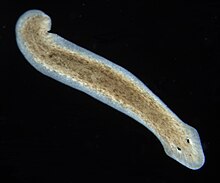Dugesia
| Dugesia | |
|---|---|
 |
|
| Dugesia subtentaculata | |
| Scientific classification | |
| Kingdom: | Animalia |
| Phylum: | Platyhelminthes |
| Class: | Rhabditophora |
| Order: | Tricladida |
| Suborder: | Continenticola |
| Superfamily: | Geoplanoidea |
| Family: | Dugesiidae |
| Genus: |
Dugesia Girard, 1850 |
| Species | |
 |
|
| Distribution of genus Dugesia after Sluys et al. 1998. | |
| External identifiers for Dugesia | |
|---|---|
| WoRMS | 181568 |
Dugesia (pronounced, d(y)üˈjēzh(ē)ə) is a genus of dugesiid triclad that contains some common representatives of the class Turbellaria. These common flatworms are found in freshwater habitats of Africa, Europe, Middle East, Asia and Australia. Dugesia is best known to non-specialists because of its regeneration capacities.
Dugesia is the type genus of the family Dugesiidae.
Dugesia species have an elongated body with a slightly triangle-shaped head. Usually they have grey, brown or black colors on the dorsal body surface, the ventral surface uses to be paler. These animals have a couple of eyes constituted by a multicellular pigmented cup with many retinal cells to detect the amount of light in the nearby environment. Sometimes they present supernumerary eyes. At the anterior part of the body, behind the eyes level, they have two of structures called auricles that give the triangle look to the 'head' and that allow them to detect the intensity of water current. These auricles are free of pigment and rhabdites. Each side of the anterior margin of the head have between 5 and 10 shallow sensory fossae, their number depends on the species or the individual. The sensory fossae and the auricle grooves are supplied with many nerve endings.
Dugesia digestion tract consists of a central non-pigmented tubular pharynx. Like the other triclads Dugesia gut consists in three ramified branches. Each branch consists of ceca, which delivers the nutrients to the body. This worm has a sac digestive plan, that is, it does not have a separate opening for waste excretion.
Subepidermal musculature is divided in four layers.
In Dugesia the ovaries are ventrally situated, they start just behind the brain, usually at the level of the fourth intestinal branch. The bursal canal runs on the right side of the copulatory apparatus and above the atrium. Like some Neppia species, Dugesia have a third layer of longitudinal musculature over the vaginal area of the bursal canal. This feature is not present in other triclads. Another feature shared with Neppia is the presence of a glandular area at the transicional area between the seminal vesicle and the ejaculatory duct, although in Dugesia these glands are concentrated at the diaphragm, a structure not present in any other genera. Ball proposed that the presence of this glands was a synapomorphy of Dugesia and Neppia. The absence of these glands in some Neppia species (N. jeanneli, N. montana and N. schubarti) is thought to be a secondary loss.
...
Wikipedia
